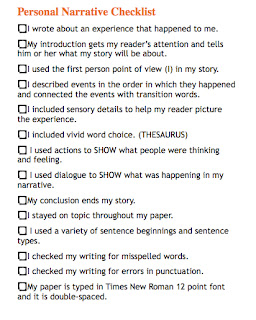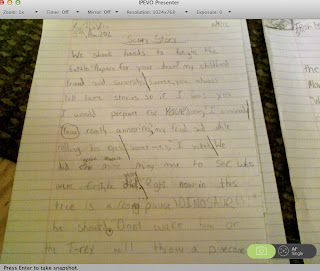Teaching the required elements of an assigned writing genre is a challenge in and of itself. Whether it's the figurative language and sensory detail needed to make a personal narrative come to life, or the evidence and examples needed to back up the writer's point of view in a persuasive piece, good writing teachers find mentor texts, create anchor charts, and model, model, model the necessary strategies during shared writing. After a couple weeks, we all pray that our students have mastered the use of the writing elements we've presented. We're usually secretly confident that they have, because, after all, they've been scribbling away in their writer's notebooks for days and days.
In actuality, we know there has been SOME transfer of the required skills because children have been bringing us their work all along and asking us to look at what they've done. We've also been "spot conferencing" with kids. Sometimes, stopping to "nudge" a child who seems stuck. Other times, putting the breaks on an overzealous writer who is getting derailed by a tangent.
We celebrate the small successes each day, stopping to share an exceptional sentence or phrase we've come across in someone's work in hopes of inspiring similar genius in all our students. (Reading examples of students' work that meets my expectations for an assignment is actually one of my favorite scaffolding strategies in writing.)
When we reach the final stages of the writing process, a small alarm goes off inside of me because it's time for the kids to edit and revise their own work, and I know how hard it's going to be. I know my students don't have a sophisticated enough eye, yet, to see where their work needs to be improved or corrected. In their minds, they've worked really hard getting their ideas on paper, so they assume their work must be "right" already.
I also know it's my responsibility to develop my students' "critical eye", so I've become the queen of writing checklists. Here is the one we're using for personal narratives right now. (I found it online and modified it to meet my students' needs.) Comment below with your email address if you want me to send you the document.
You're thinking, "Yeah, yeah. Been there, done that, and my students still can't edit and revise independently." If you're anything like me, you've gotten more than your fair share of completed checklists attached to papers that fall far short of your expectations for the assignment.
Fret no more! I have one more trick up my sleeve that is helping my students to become more independent revisers of their own work. Have you ever seen one of these?
It's called a document camera. This one is from Ipevo and you can get it for around $70.00. I've posted a link, if you want to check it out for yourself. You're probably thinking $70.00 is a lot of money, so this thing better be able to do some real magic. Well, it does! It does this:
I know this image is hard to see, but that is one of my student's writing drafts. When it appears on the SMARTBoard, it is large enough and clear enough for everybody to see, AND it is an authentic example of student work. Trust me when I tell you I have the undivided attention of every writer in my class the moment I project someone's work up on the board using the document camera.
Now, I don't just project any random piece of work in class. I carefully choose examples that demonstrate the types of revisions I want my students to practice. In the personal narratives we are working on right now, the children really need help seeing where to add figurative language into their writing and how to substitute vivid, descriptive language for more general words. This paper is a perfect way to SHOW them how to do both.
Drink and breakfast can become mocha latte and a juicy, delicious bacon, egg, and cheese bagel as we discuss the writing sample on the board. We can talk about how "saying Sophisticated Styles a thousand times" is hyperbole and it shows that the phone rings a lot in this salon.
Ideally, the students would have their own drafts in front of them at this point. I can stop and have everyone make at least two substitutions and add one example of figurative language in their own work. I'm able to reach everybody in one shot, and that leaves room for differentiation. The children who are able to can make the revisions independently and move on, and that leaves me more time to work with the children who are still struggling with the skills.
If you're thinking you would love to use a document camera to facilitate revision in your classroom, please take a look at the link for the Ipevo camera I use in my room. It's reasonably priced and easy-to-use. If you've already spent enough money on materials for your class this year, I looked up document cameras on Donors Choose.org (
www.donorschoose.org), and teachers have had their requests for document cameras funded on the site. Either way, consider adding this powerful tool to your teaching toolbox. I'll even tell you how you can use it to model problem solving in math class in a future post.




































